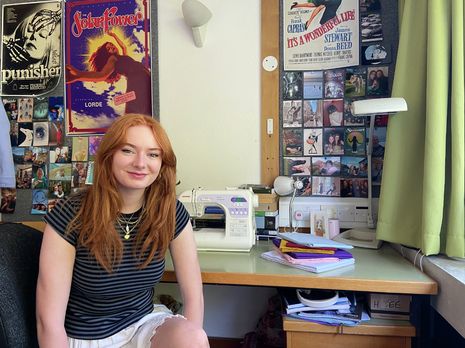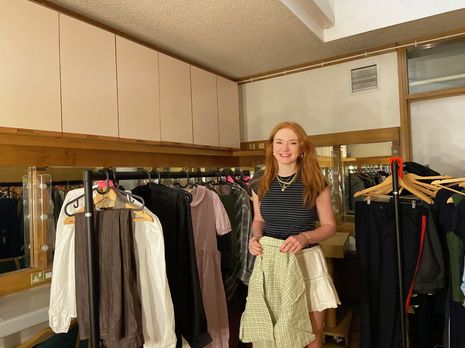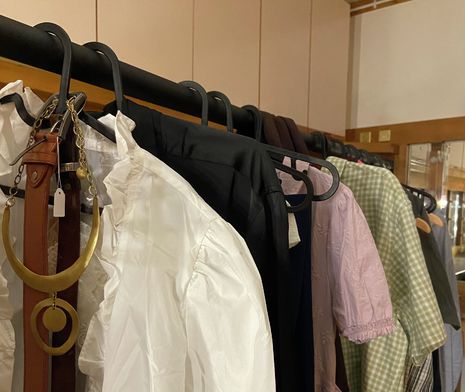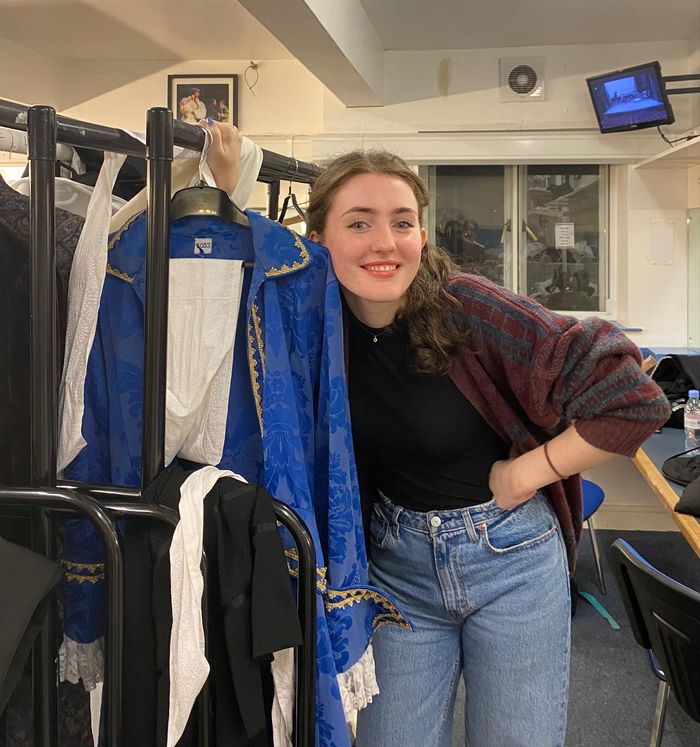Behind the seams of A Midsummer Night’s Dream
We sit down with Hattie Lee to talk all things costume design for the Cloister Court May Week production

Hattie’s desk is a revealing insight into her role as set and costume designer for the May Week production of A Midsummer Night’s Dream, a labour of love that she has balanced alongside her English degree. A copy of King Lear sits atop a stack of hefty books, and in front lies her sewing machine and a pile of fabric which I’m informed will adorn Cloister Court as bunting – “that’s this afternoon’s job!” Hattie tells me.
“The whole idea of this reading of the play is this flowery surface, darker – like the thorns beneath the rose”
Hattie admits that this is the first time she is turning her hand to costume design, but that her lifelong interest in fashion and the fact that “studying theatre is a massive deal for English students” means that sewing together literature and design is an ideal decision. She adds that costume design is an art form: “You have to portray ideas and the feelings and beliefs that a person has through how they’re dressed.”
Hattie’s English background is a wellspring of inspiration. In creating costumes, Hattie interweaves her knowledge of literary themes into her visions, as she reveals that spending Easter term creating a Shakespeare portfolio has aided her perception and reading of the play. “I think it encourages us to think more in depth about ideas that we wouldn’t necessarily do otherwise, and kind of pushes us to change our perceptions,” she says. Hattie goes on to tell me about small references in the text that transform into larger motifs throughout the set and costuming: “Titania is known for having certain flowers, so we made a mood board of all the flowers that she is said to have in the play … the colour scheme is all from the colours of the flowers mentioned”.

I ask her whether contemporary audiences require more avant-garde attire, or if the fact that the play is so familiar makes it harder to stray from conventional costumes. She highlights that, when staging a Shakespearean production, “you either choose something very modern, or you go down the kind of traditional route … I think we’ve arrived on the side of tradition in that it’s a Cloister Court production”, alluding to the quintessential Tudor architecture of the setting. Hattie points out: “Because it’s been done so many times, you can just go slightly off-piste, but not so much that it changes the meaning because everyone knows what’s happening”. She adds that, while A Midsummer Night’s Dream is, of course, a whimsical comedy, it is underscored by darker themes which are reflected in her costume choices, drawing inspiration from the horror film Midsommar. “We’re not trying to break boundaries,” she adds, “we’re trying to pull on the darker undertones of the play and have the characters seem that little bit edgier, Oberon in particular will have a foreboding presence”.
“Costume design is not just a case of buying outfits and making sure they fit, but exploring storytelling through design”
Costume design is no mean feat. We discuss the myriad challenges involved, such as sustainably sourcing costumes. “We’ve thrifted a lot of things and then we’re also loaning out costumes from the Queens’ costume store … we’ve really tried to be as sustainable as possible,” Hattie tells me, emphasising the importance of mindful sourcing and praising the Grafton charity shops. However, the constraints of charity shops, such as sizing and convenience, still necessitates the use of fast fashion brands. “We bought some things new,” Hattie confesses, “you can’t fully change your vision all the time if things aren’t available”. Indeed, costume design is not just a case of buying outfits and making sure they fit, but enhancing them and exploring storytelling through design. Hattie expresses that “this has definitely been a two-person job!”, as her workload has been eased through collaboration with co-designer Zara Tosun.

Our conversation inevitably moves to discussing the iconic setting of Cloister Court, by the oldest building on the Cam. I ask Hattie how the set interacts with the costumes; “the space was so ideal that we’ve done a very minimal set, more pared back because everything around it is already saying exactly what we need it to say”. In contrast, she notes that the costumes will be more intricate “because it’s a daytime open-air production … so the audience is very close up”. We discuss how the space is rich with flowers and nature, and Hattie explains that this was well-planned as “the whole idea of this reading of the play is this flowery surface, darker undertone – kind of like the thorns beneath the rose”. Working on both the set and costume has enabled Hattie to seamlessly weave similar concepts between the two elements: “Cloister Court has lots of greenery, so we’ve been sympathetic to that by not putting as much green in our colour scheme to make that a more vibrant background”.
We end our interview in the backstage dressing-room-turned-costume-store. Scanning through the carefully curated rails, one costume immediately catches my eye. I ask Hattie about it and her eyes instantly light up. “Puck is my passion project,” she tells me, sharing how she drew inspiration from David Bowie’s Labyrinth, Grimms’ Fairy Tales, and folklore: “Puck was my most set vision, and that was more challenging because I had to realise it, but it’s really come to fruition”.
Hattie informs me that the opening night falls on summer solstice, so there is no better way to celebrate Midsummer than by watching these dreamy costumes bring this play to life.
A Midsummer Night’s Dream opens on Wednesday 21 June at Queens’ Cloister Court.
 News / Cambridge students set up encampment calling for Israel divestment6 May 2024
News / Cambridge students set up encampment calling for Israel divestment6 May 2024 News / Cambridge postgrad re-elected as City councillor4 May 2024
News / Cambridge postgrad re-elected as City councillor4 May 2024 News / Proposed changes to Cambridge exam resits remain stricter than most7 May 2024
News / Proposed changes to Cambridge exam resits remain stricter than most7 May 2024 News / Some supervisors’ effective pay rate £3 below living wage, new report finds5 May 2024
News / Some supervisors’ effective pay rate £3 below living wage, new report finds5 May 2024 Fashion / Class and closeted identities: how do fits fit into our cultures?6 May 2024
Fashion / Class and closeted identities: how do fits fit into our cultures?6 May 2024






